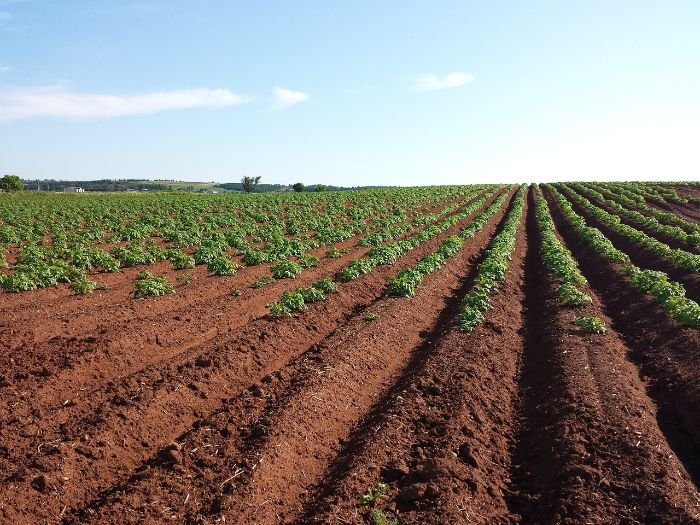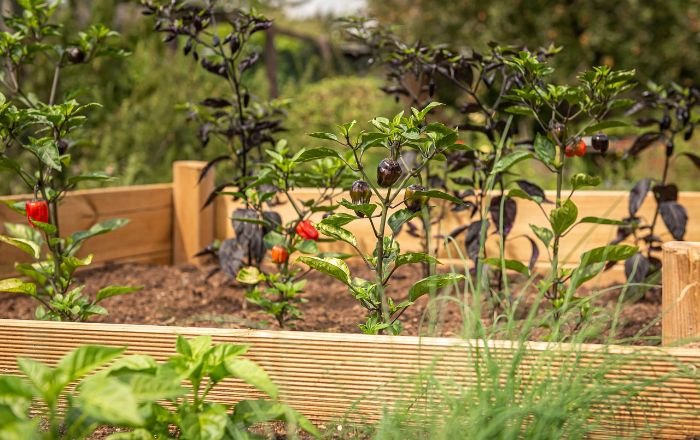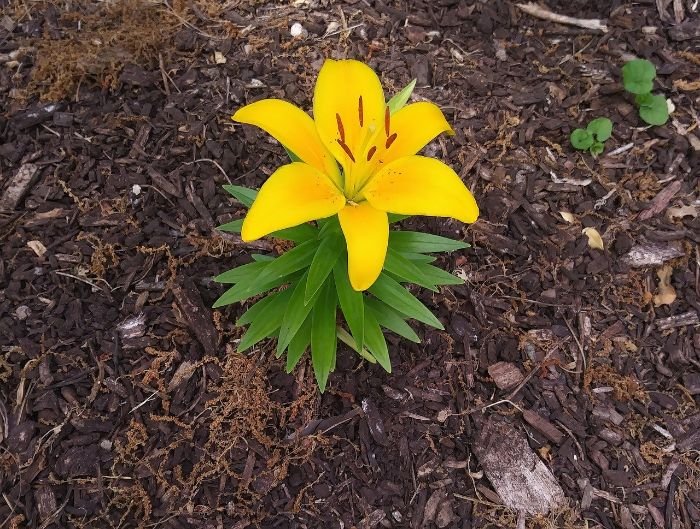Poor drainage can be fixed with clear steps – test, amend, and install systems where needed. Standing water suffocates roots and invites disease. Start with a 12-inch percolation test after a pre-soak and record drop rate; 1-2 inches per hour is workable, water left after four hours flags restriction. Set grade to fall 2-3% away from structures and route downspouts at least 10 feet from beds. Loosen compacted zones during dry weather, then add 1-2 inches of mature compost to build stable aggregates. Skip sand in clay; apply gypsum only when a soil test confirms sodicity. For chronic saturation, lift roots in 8-12-inch raised beds or install a French drain with a 4-inch perforated pipe wrapped in geotextile, surrounded by ¾-inch gravel, and sloped about 1% to a safe outlet.
Key Takeaways
- Run a 12-inch percolation test; <1 in/hr or standing water at 4 hours indicates poor soil drainage that needs correction.
- Control inputs first – create a 2-3% grade away from structures and extend downspouts 10+ feet to prevent waterlogging in beds.
- Improve soil drainage naturally – relieve compaction in dry conditions, top-dress 1-2 inches of compost, and use cover crops with deep roots; reserve gypsum only for sodic clays verified by a lab test.
- Choose structural fixes when needed – build 8-12-inch raised beds or add a French drain (4-inch perforated pipe, geotextile wrap, ¾-inch gravel, ~1% slope) to move excess water.
- Identify the best soil for drainage – loam with balanced sand, silt, and clay fractions offers steady infiltration and holds nutrients, making it ideal for productive garden beds.
Table of Contents
What Causes Poor Soil Drainage in Gardens
Waterlogging usually traces back to a few repeatable drivers. Compaction closes pore space and traps water around roots. Clay‑heavy subsoil slows percolation long after rain stops. Poor grading funnels roof and surface runoff into low spots. High water tables keep pores filled from below. Pinpointing the dominant driver saves work, because each problem responds to a different fix.
Soil compaction from traffic and tilling when wet
Foot traffic, wheelbarrows, and mowers press particles together, especially after storms. Repeated tilling in a wet state smears aggregates into a dense layer. Bulk density rises, oxygen drops, and roots stall. Field signals include footprints that hold shape, a shovel that resists entry, and a surface sheen after light rain. I confirm compaction with a simple screwdriver test; if the tool will not push in past a few inches, pore space is limited.
Clay‑dominant subsoil and hardpan layers
Fine clay particles swell when wet and seal pore openings as water moves across the surface. Construction equipment or years of shallow tillage can leave a dense hardpan 6-12 inches below grade. Water sits above that layer because downward flow is restricted. Expect puddles that linger even when the top inch appears dry and a sticky smear on the spade face when digging.
Flat or negative grade with concentrated runoff
Beds that sit level or slope toward a structure collect water faster than soil can accept it. Downspouts that discharge beside beds, poorly designed or tight garden pathways and patio edges channel flow into one zone. The result is standing water along borders and scoured mulch after heavy rain. A quick check with a 2-4 foot level across several points often reveals no fall or a reverse slope.
High water table and perched water above restrictive layers
In some sites groundwater rises close to the surface during winter or spring. Water then fills pores from below, even without rain. A different pattern appears where a restrictive layer creates perched water – the hole drains slowly until the water level matches the layer, then stops. Clues include water that returns overnight after bailing and hydrophytic weeds that thrive through cool seasons.
Irrigation and drainage outlet errors
Controllers set to frequent short cycles keep soil near saturation. Clogged French drains, buried outlets, and silted catch basins remove the escape route that water needs. Expect moss on shaded soil, algae on hardscape edges, and a sour smell near outlets after long wet periods.
Quick cause-signal map
| Primary cause | Mechanism | Field signals that stand out |
|---|---|---|
| Compaction | Pores collapse under traffic and wet tillage | Footprints hold shape, screwdriver will not penetrate, surface sheen after light rain |
| Clay subsoil or hardpan | Fine particles or dense layer restrict percolation | Puddles above a firm layer, sticky smear on spade, slow drainage despite dry surface |
| Poor grade and runoff concentration | Water flows into beds faster than infiltration | Standing water along borders, scoured mulch near downspouts, level shows no fall |
| High water table or perched water | Groundwater or restrictive layer keeps pores filled | Water returns overnight in test holes, wet‑loving weeds persist |
| Irrigation or outlet issues | Excess input or blocked exits | Moss and algae growth, sour odor, stagnant water at outlets |
Knowing which driver is active guides the remedy.
Assess Soil Drainage with Field‑Ready Tests
Accurate diagnosis saves time and money. Simple tests show whether the problem is compaction, clay restriction, runoff, or a high water table. Results guide the fix, the season for doing the work, and the right depth for any drain or raised bed.
Percolation test – depth, timing, and interpretation
Dig a hole about 12 inches deep and 8-12 inches wide. Pre‑soak once to wet the profile, then refill to the top. Measure the drop every 30 minutes for two hours and again at four hours. Record soil temperature and recent rainfall so results have context. Healthy garden soil usually falls 1-2 inches per hour. Water that remains after four hours points to poor drainage or a restrictive layer.
Stop the test if the hole drains rapidly for an hour and then stalls at one level. That plateau often marks a hardpan or a clay‑dense horizon. Mark the depth; that number informs how deep to fork, rip, or set a French drain.
Infiltration ring for surface intake
A bottomless can or short section of 4‑inch pipe can measure surface intake. Press it an inch into soil, add a measured inch of water, and time how long it takes to disappear. Fast intake with slow percolation in the deeper hole suggests crusting or surface compaction over a tight sublayer. Slow intake at the surface points to sealing from fine particles or traffic.
I log infiltration times during spring and fall because temperature and biology change the rate. Warmer, biologically active soil often accepts water faster.
Slope and runoff checks with a line level
Set a string line across the problem area and hang a small level. Measure the drop over 10 feet. A functional garden grade falls about 2-3 percent away from structures, which equals 2.4-3.6 inches over 10 feet. Zero fall, reverse slopes, or downspouts that empty beside beds direct water into low points faster than soil can accept it.
Watch how water moves during the first minutes of a storm. Channels on paths, eroded mulch fans near patio edges, and pooling against bed borders confirm a grading or routing issue rather than a soil‑only problem.
Plant and soil signals that confirm drainage failure
Chlorosis on lower leaves, stunted growth, and root tips that smell sour indicate oxygen starvation. Moss on shaded soil and black anaerobic patches under mulch mark prolonged saturation. Cracks that open after a dry week in clay soil show shrinking and swelling cycles tied to poor structure. Pull a plant and examine roots. Clean, white roots point to adequate oxygen. Brown, mushy roots point to waterlogged conditions.
High water table and perched water identification
A high water table keeps pores filled from below. A test hole that refills overnight after bailing is a clear sign. Perched water forms when a restrictive layer sits above freer‑draining soil. In that case the percolation test drains to the layer and then stops. The fix differs – raised beds or shallow drains help with a high table, while subsoiling, deep organic amendments, or a drain set just above the restrictive layer help with perched water.
Drainage assessment guide
| Method | How to perform | Healthy result | Problem indicator |
|---|---|---|---|
| Percolation hole (12 in) | Pre‑soak, refill, measure drop for 2-4 h | 1-2 in/hr, no standing water at 4 h | Water remains at 4 h, or drainage stalls at a fixed depth |
| Infiltration ring | 1 in water inside a pressed ring | Rapid intake that matches percolation rate | Slow intake at surface, crusting, or sealing |
| Grade check | String line and level over 10 ft | 2-3% fall away from structures | Zero fall, reverse slope toward beds |
| Root inspection | Uproot one plant carefully | Firm, white roots | Brown, soft roots with sour odor |
| Overnight refill test | Bail hole in evening, recheck morning | Stable low water level | Water rises back near surface |
Clear measurements turn observation into action. With the cause and severity defined, you can select the right remedy.
Improve Soil Structure to Boost Drainage
Drainage improves when soil gains stable pores and stronger aggregates. Two levers do most of the work – organic matter that glues particles into crumbs and mechanical loosening that opens pathways for water and roots. Chemical adjustments help only in special cases. A targeted plan prevents wasted effort and avoids common mistakes like tilling when wet or mixing sand into clay.

Add stable organic matter the right way
Mature compost raises aggregation and water entry. Spread 1-2 inches over beds and work it into the top 3-4 inches during a dry window, or leave a surface layer for worms to mix gradually. Compost should smell earthy, test near neutral pH, and show temperatures that have settled after active composting. High‑salt compost slows roots and worsens water stress, so check labels for electrical conductivity or do a quick taste test; saline compost tastes noticeably sharp.
Shredded leaves and fine wood chips form a cap that reduces crusting. Apply 2 inches after planting, then top‑up each season. Mulch slows raindrop impact, which keeps pores open near the surface. I top‑dress beds every fall so winter freeze‑thaw and soil life can integrate material before spring.
Relieve compaction without creating more
Broadforking opens vertical channels without inversion. Insert tines 8-12 inches deep, rock back just enough to lift, and move six inches at a time. Avoid levering when soil is wet to prevent smearing. Paths and lawn edges respond better to core aeration; hollow tines remove plugs that decompose and leave air‑filled space. Rotary tillers can smear wet clay into a pan, so reserve deep tillage for rare resets during dry spells and follow with organic matter to stabilize gains.
Use living roots for bio‑drilling
Deep‑rooted cover crops create channels that persist after decomposition. Daikon radish pushes through tight layers in late summer and leaves pores by spring. Annual ryegrass weaves a dense root net that resists collapse under foot traffic. Mix a legume where nitrogen is needed next season. Terminate before seed set and allow two to three weeks for soft tissue to break down before direct seeding small crops.
Correct clay constraints with precise chemistry
Gypsum (calcium sulfate) flocculates sodic clays by replacing sodium on exchange sites. That reaction improves structure and drainage only when sodium levels are high.
A simple rule keeps efforts efficient – apply gypsum after a soil test flags sodium or high exchangeable sodium percentage. Where sodium is normal, focus on organic matter and mechanical loosening. Avoid adding sand to clay, which can produce a hard, brick‑like matrix.
Small doses of biochar can help in heavy soils by adding stable pore space. Blend no more than 5-10% by volume into the top layer and pre‑charge with compost or diluted fertilizer to prevent short‑term nutrient lockup.
Manage the surface to increase intake
Crusts slow infiltration long before deeper layers are reached. Rake lightly after heavy rain to break sealed films. Keep pathways permeable with gravel or wood chips so water enters soil instead of running onto beds. Redirect downspouts away from low points before any soil work; improved intake cannot overcome concentrated runoff pointed at a single border.
Quick reference: pick the right structural fix
| Situation | What to use | How to apply | Expected response time |
|---|---|---|---|
| Compacted beds with poor root growth | Broadfork + 1-2 in compost | Loosen 8-12 in deep during dry weather, amend top layer | Immediate improvement in infiltration; stronger structure over one season |
| Surface sealing after storms | Mulch + light raking | Apply 2 in shredded leaves/wood chips; break crusts post‑rain | Faster intake at surface within weeks |
| Heavy clay with normal sodium | Organic matter + patient loosening | Seasonal compost top‑dress; avoid sand | Gradual gains across one to two seasons |
| Sodic clay (confirmed by test) | Gypsum | Follow lab rate; water in | Noticeable aggregation within months |
| Need deeper pores without tillage | Deep‑rooted cover crop | Seed daikon late summer or ryegrass in fall; terminate on time | Pore continuity improves by next planting window |
Soil that gains structure drains predictably. Organic matter builds the scaffold, mechanical loosening opens routes, and targeted chemistry solves edge cases. With structure on your side, water moves into the profile instead of sitting on the surface, and roots find air along the full depth of the bed.
Garden Drainage Systems and Design Fixes
When water persists despite soil improvements, structural interventions redirect excess away from beds. Simple grading, raised growing zones, or buried drains handle conditions that organic matter alone cannot. Choosing the right system depends on slope, soil type, and the volume of water entering the site.
Raised beds to lift roots above saturation
Elevating soil 8-12 inches above grade provides immediate relief in chronically wet plots. A frame of rot-resistant wood, stone, or metal confines the mix. Fill with a blend of topsoil and compost that balances porosity and fertility. Raised beds warm faster in spring, drain freely after storms, and protect roots from high water tables.

Keep sides open to the subsoil when possible so worms and water can still move between layers.
French drains for subsurface water movement
A French drain is a trench, usually 12-18 inches deep, that carries water away from saturated ground. At the base lies a 4-inch perforated pipe wrapped in geotextile to block silt, surrounded by ¾-inch washed gravel. The pipe must slope about 1% (roughly 1 foot drop over 100 feet), to maintain flow. Outlets should empty into a dry well, swale, or storm line.
Regular inspection keeps sediment from sealing the pipe. I’ve seen gardens recover within a season once excess water had a clean exit path.
Swales and grading adjustments
Where yards accept large volumes of surface runoff, shallow swales spread and slow water before it enters beds. A well-shaped swale follows contour, lined with turf or deep-rooted perennials. Grade correction can be subtle; a 2-3% fall over 10 feet moves water effectively without noticeable slope. Redirect downspouts into swales rather than beside planting areas.
Permeable hardscapes that reduce runoff
Dense patios and narrow paths can funnel water into beds. Replacing impermeable surfaces with permeable pavers, gravel paths, or open-joint designs increases infiltration. Materials with voids allow rainfall to soak where it lands. Combining hardscape changes with subsurface drains prevents one zone from carrying all the load.
Quick comparison of garden drainage systems
| Method | Best suited for | Depth/Height | Key considerations |
|---|---|---|---|
| Raised bed | High water table, small plots | 8-12 in above grade | Needs quality fill; frame maintenance |
| French drain | Saturated soils, clay subsoil | 12-18 in trench | Pipe slope ~1%; outlet required |
| Swale/grade | Large runoff, uneven yards | Surface reshaping | 2-3% slope; plant cover to stabilize |
| Permeable hardscape | Patios, pathways causing runoff | Surface | Materials must stay weed-free; periodic refilling |
Well-chosen systems move excess water without harming soil structure. Once outlets and grades are corrected, even heavy rains pass through the site without drowning roots.
Prevent Future Drainage Failures
Corrective work solves current waterlogging, but drainage only holds if the garden is managed to resist compaction, silting, and seasonal stress. Routine checks, adaptive planting, and thoughtful surface care keep soil open and outlets clear year after year.
Seasonal soil care and aeration
Soil tightens naturally under rain and foot traffic. Light aeration each fall and spring maintains pore continuity. In beds, a broadfork used during dry weather lifts without inversion. In lawns or high-traffic areas, core aeration every second year removes plugs and prevents thatch from sealing the surface. Avoid stepping on beds when wet; one misplaced wheelbarrow load can collapse pore space that took months to build.
Mulch and cover management
Mulch stabilizes moisture while shielding the surface from crusting. Apply 2-3 inches of shredded leaves, wood chips, or composted bark each season. Renew layers before winter to protect against pounding rains and freeze-thaw. Living covers such as clover or ryegrass further defend soil against raindrop impact. Terminate covers before seed set and leave residue as surface armor.

Adaptive irrigation to avoid saturation
Over-watering undoes drainage work faster than storms. Match irrigation to infiltration capacity. Long, infrequent cycles soak deeper and encourage roots to chase moisture. Frequent shallow cycles keep the surface waterlogged and starve roots of air. Automated controllers should be recalibrated seasonally, and rain sensors or soil moisture probes should override default schedules.
Planting choices that tolerate occasional wetness
Some sites will always carry risk of saturation during extreme weather. Planting adapted species in marginal zones avoids loss. Swamp milkweed, red osier dogwood, and certain sedges tolerate periodic wet feet while still contributing biomass and cover. Reserve higher-value crops for raised beds and better-drained sectors.
Inspection of outlets and hard surfaces
Drainage systems degrade quietly. Check French drains, catch basins, and outlets each season for silt and roots. Flush pipes if flow slows. Sweep permeable pavers and top up joint material to maintain infiltration. Keep downspout extensions firmly connected and directed to swales. A ten-minute walk after heavy rain often reveals blockages before they cause flooding.
Long-term drainage maintenance guide
| Practice | Timing | Expected effect |
|---|---|---|
| Broadfork or core aeration | Fall/spring | Maintains pore continuity, reduces compaction |
| Mulch or cover crops | Seasonal | Protects surface, raises organic matter |
| Irrigation recalibration | Seasonal | Prevents artificial waterlogging |
| Outlet inspection | Post-storm and fall cleanup | Ensures flow paths remain open |
| Planting wet-tolerant species | At establishment | Reduces crop loss in marginal zones |
Consistent habits keep the soil’s structure resilient and the drainage systems functional. With seasonal checks and adaptive planting, gardens resist saturation even under erratic rainfall, leaving roots in oxygen-rich ground and harvests protected.
Conclusion – Lasting Solutions for Waterlogged Gardens
Effective drainage comes from accurate diagnosis and targeted action. A percolation test or slope check defines the problem, while compost, aeration, and bio-drilling reshape soil structure. Structural systems such as raised beds or French drains then move excess water safely away. Long-term resilience depends on seasonal care – mulch, cover crops, calibrated irrigation, and regular inspection of outlets.
I have seen gardens recover quickly once water is given both space to enter and a path to leave. The soil responds with stronger aggregates, roots regain oxygen, and plants resume steady growth. With measured improvements and consistent upkeep, even a site prone to saturation can shift into a garden that drains reliably through every season.
FAQ
Why is soil drainage important for healthy plants?
Good drainage keeps roots supplied with oxygen and prevents the buildup of toxic compounds in saturated soil. Without it, roots suffocate, nutrient uptake declines, and fungal diseases spread. Well-drained beds also warm faster in spring, allowing earlier planting and more consistent growth through the season.
How do you test soil drainage in a garden?
Dig a hole about 12 inches deep, fill it with water once to pre-soak, then refill to the top. Measure how fast the water level drops. Healthy soil drains at roughly 1-2 inches per hour. If water remains after four hours, or if the hole drains rapidly at first but stalls at one depth, the site has a restriction such as compaction, clay, or a high water table.
What is the best soil for drainage?
Loam with balanced sand, silt, and clay fractions gives the most reliable drainage. It holds water for crops but still leaves air in the pore spaces. Sandy soils drain quickly but often leach nutrients, while heavy clays retain water too long. Amending either extreme with mature compost improves structure and makes water flow more evenly.
How can you improve soil drainage without major construction?
Add 1-2 inches of compost each season to build aggregation, aerate compacted zones with a broadfork during dry weather, and use deep-rooted cover crops such as daikon radish or annual ryegrass to create bio-pores. Mulching with shredded leaves or wood chips also reduces surface sealing and increases infiltration after storms.
What are the main types of garden soil drainage systems?
Common systems include raised beds, French drains, grading with swales, and permeable paving around paths or patios. Raised beds lift crops above saturation, French drains move excess water through a gravel-lined pipe, swales redirect surface flow, and permeable hardscapes reduce runoff by allowing rain to soak where it lands.
Can raised beds solve drainage problems in clay soil?
Yes. Raised beds filled with a balanced soil-and-compost mix lift roots above saturation and prevent crop losses in waterlogged clay. Heights of 8-12 inches are usually enough for vegetables. Leave the base open to the subsoil so earthworms and excess water can move freely.
Which plants tolerate poorly drained soil?
Species adapted to wet conditions survive where vegetables would fail. Examples include swamp milkweed, red osier dogwood, winterberry, blue flag iris, and several sedges. They possess air-filled tissues in roots that move oxygen into saturated zones. Place sensitive food crops in raised beds and use wet-tolerant ornamentals only in marginal areas.










